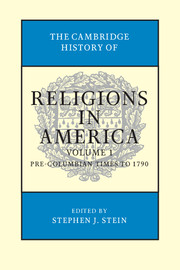Book contents
- Frontmatter
- Contents
- Contributors
- Editor's Introduction
- SECTION I BACKGROUND ON RELIGIOUS TRADITIONS – PRE-1500S
- SECTION II RELIGIONS IN THE POST-COLUMBIAN NEW WORLD – 1500–1680S
- SECTION III RELIGIOUS PATTERNS IN COLONIAL AMERICA – 1680S–1730S
- 12 Spanish Catholicism in the Caribbean, New Spain, and the Northern Frontiers
- 13 French Catholicism in New France
- 14 Congregationalist Hegemony in New England, from the 1680s to the 1730s
- 15 The Middle Colonies, 1680–1730
- 16 Religion in the Southern English Colonies, 1680s–1730s
- SECTION IV RELIGIOUS DIVERSITY IN BRITISH AMERICA – 1730S–1790
- SECTION V AMERICAN RELIGIONS IN THE EIGHTEENTH-CENTURY INTERNATIONAL CONTEXT
- SECTION VI THEMATIC ESSAYS
- Index
- References
15 - The Middle Colonies, 1680–1730
from SECTION III - RELIGIOUS PATTERNS IN COLONIAL AMERICA – 1680S–1730S
Published online by Cambridge University Press: 28 July 2012
- Frontmatter
- Contents
- Contributors
- Editor's Introduction
- SECTION I BACKGROUND ON RELIGIOUS TRADITIONS – PRE-1500S
- SECTION II RELIGIONS IN THE POST-COLUMBIAN NEW WORLD – 1500–1680S
- SECTION III RELIGIOUS PATTERNS IN COLONIAL AMERICA – 1680S–1730S
- 12 Spanish Catholicism in the Caribbean, New Spain, and the Northern Frontiers
- 13 French Catholicism in New France
- 14 Congregationalist Hegemony in New England, from the 1680s to the 1730s
- 15 The Middle Colonies, 1680–1730
- 16 Religion in the Southern English Colonies, 1680s–1730s
- SECTION IV RELIGIOUS DIVERSITY IN BRITISH AMERICA – 1730S–1790
- SECTION V AMERICAN RELIGIONS IN THE EIGHTEENTH-CENTURY INTERNATIONAL CONTEXT
- SECTION VI THEMATIC ESSAYS
- Index
- References
Summary
More than a generation ago Carl Bridenbaugh, summing up the religious experience of the colonists on the Hudson and the Delaware, wrote, “In a region of so many nationalities – Dutch, Swedes, Finns, French, Germans, English – toleration was vital.” In contrast to the colonies to the north and south, which were largely ethnically homogeneous before 1730, with powerful established churches, Congregationalism in New England and Anglicanism in the South, the Middle Colonies – for the purposes of this essay New York, New Jersey, Pennsylvania, and Delaware – presented a diverse array of faiths and peoples. All of the following found homes there: Dutch and German Reformed; French Huguenots; Swedish and German Lutherans; Scottish, Irish, and English Presbyterians; Welsh and English Baptists; English Congregationalists; and German, English, and Welsh Quakers, not to mention a variety of other sects. Roman Catholics also achieved grudging toleration there, and by 1730 most of North America's tiny Jewish population lived in New York. Living near them, of course, were Native Americans whose religious relationship with Europeans was often uneasy. And arriving involuntarily were growing numbers of enslaved Africans, who would be a source of both missionary labor and uneasy conscience for some of their European neighbors.
This essay presents an overview of the diversity of the religious experience of the inhabitants of the Middle Colonies between 1680 and 1730, largely in terms of denominations broadly defined. It examines not only “high” matters of theology and leadership, but also elements of faith closer to the experience of the masses of worshippers. In a world in which political leadership was firmly in male hands, it looks at how these religious groups incorporated women into their communities.
- Type
- Chapter
- Information
- The Cambridge History of Religions in America , pp. 303 - 327Publisher: Cambridge University PressPrint publication year: 2000



